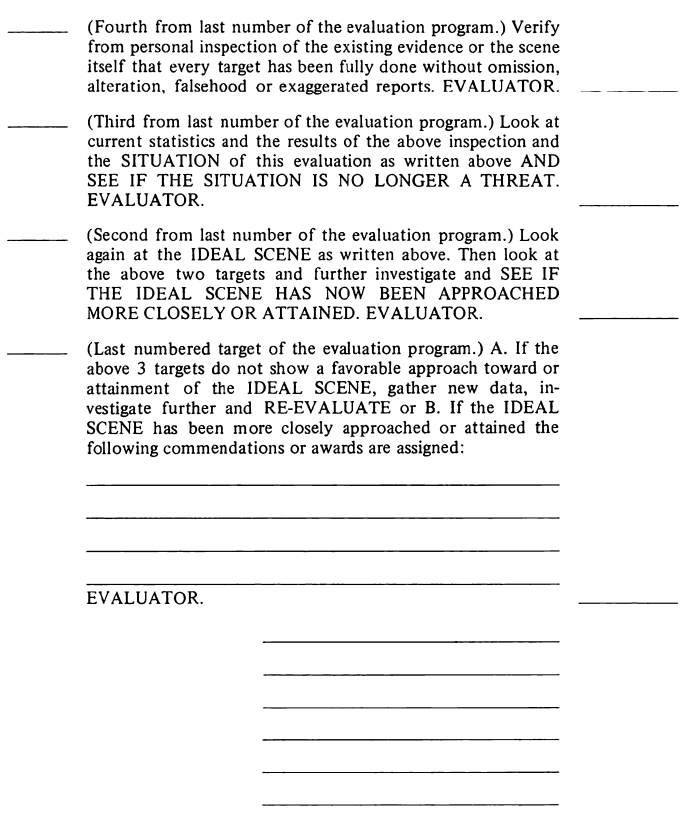


Saint Hill Manor, East Grinstead, Sussex HCO POLICY LETTER OF 25 NOVEMBER 1973 Issue I CORRECTED AND REISSUED 17 MAY 1974 | Saint Hill Manor, East Grinstead, Sussex HCO POLICY LETTER OF 25 NOVEMBER 1973-1 Issue I CORRECTED & REISSUED 17 MAY 1974 |
FINAL TARGETS | FINAL TARGET ATTACHMENT |
The first, foremost and most usual reason evaluations fail is because the programs to handle are not done. | To save the evaluator writing the final targets longhand this sheet is provided. It can be filled in with the proper numbers and data, inapplicable lines crossed out and this sheet stapled to the end of any Eval. |
The evaluator, with all the study for an Ideal Scene, the exhaustive search for data and the collection and count of outpoints and pluspoints, with the discovery thereafter of the right Why and the brightest of ideas to handle may yet be totally defeated by the simple fact that no one ever chases up the target execution and gets the program really and honestly DONE. |
|
He can even have someone who is responsible for getting his program executed only to find they are themselves issuing additional or even contrary orders. Or even issuing whole new programs which have no relation to evaluation at all. | |
Circumstances have been found where a person with the duty of getting targets done was so deficient in the ability to confront that he accepted any excuse at all and was even pushed over into other subjects. The remedy for this of course is HCO B 21 Nov 73, "The Cure of Q & A, Man's Deadliest Disease." | |
It can be so bad that persons entrusted with target execution did not even speak to or approach any person who had a target to do while not reporting at all or reporting marvelous progress with the program! | |
So, sad to have to relate, it is not enough to be a fantastic and able evaluator. If the program is never truly done, the evaluation is merely a mental exercise. | ______________________________________________________ |
The ability to supervise and obtain cooperation and execution is mandatory for the skill of any evaluator. | EVALUATOR. |
HCO P/L 1 Sept 73, "Admin Know-How No. 30" and HCO P/L 15 Oct 73, Admin Know-How Series 31, "Administrative Skill," give the evaluator some of the additional data he needs to obtain execution of his programs. | {{Editor: On the pic is shown how it looks in Green Volumes.}} |
One can say right here that the thought, "Oh well, I'm just a sort of technician here and it's really not up to me to RUN things. I just evaluate and it's up to 'them' to see that they carry it out," is very likely to occur. |  |
But if one's repute as an evaluator is to be established, it will come about because | Founder |
THE EXISTING SCENE MOVED UP MARKEDLY TOWARD OR BECAME THE IDEAL SCENE. | |
If that does not occur, then seniors or workers don't blame the supervisors or communicators. They blame the evaluator. "Oh him! He evaluated the building situation and look, the whole situation went to hell." | [Note: The 17 May ’74 reissue corrected a typographical error in the original mimeo.] |
No justice at all. The data and Why and all the rest were quite right. The on-paper evaluation was perfect. It would have "handled the hell" out of it. But lamentably the program just was never done. Altered or falsely reported or untouched, the targets just weren't done. | |
So the test of an evaluation is | |
DID IT MOVE THE EXISTING SCENE TOWARD OR ATTAIN THE IDEAL SCENE? | |
And that cannot occur without the program being fully and totally and correctly done. | |
See also HCO P/L 26 Jan 72, "Not-dones, Half-dones and Backlogs" for more data on this. | |
Thus it is VITAL that four final targets exist on every evaluation. | |
These are | |
| |
__________________________________________________________________________ | |
__________________________________________________________________________ | |
__________________________________________________________________________ | |
__________________________________________________________________________ | |
EVALUATOR. __________ | |
This signifies the conclusion of the evaluation. | |
(Note: The last four targets may be made available on a mimeograph sheet for the use of an evaluator in ending off his evaluation.) | |
By using this program ending, it is abundantly clear to all those concerned with the evaluation including the evaluator that | |
THE PROGRAM AND ITS SUCCESSFUL EXECUTION ARE AN INTEGRAL PART OF AN EVALUATION. | |
Unless the program is fully, truthfully and successfully done, an evaluation alone cannot remedy any situation and the ideal scene will not be attained. | |
The reason for and the final objective of any evaluation is the approach toward or attainment of the IDEAL SCENE. | |
Founder | |
[Note:'' The 17 May 1974 reissue corrected a typographical error in the original mimeo.] | |